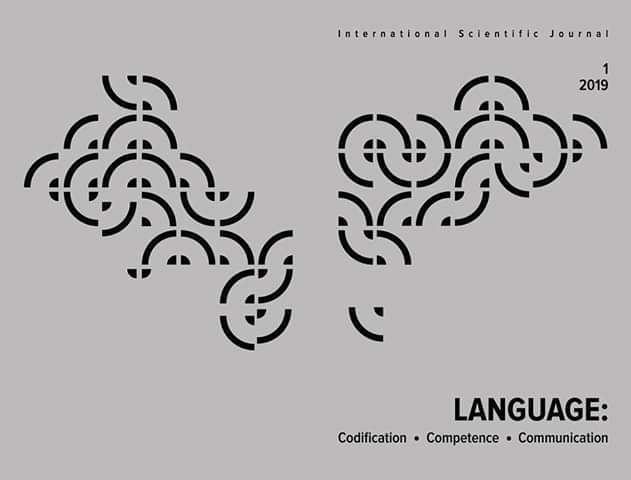THE PROBLEM OF EMPLOYING TRANSLATION TRANSFORMATIONS WHILE TRANSLATING AN ART WORK
DOI:
https://doi.org/10.24025/2707-0573.1.2019.169442Abstract
Problem statement. The topicality of the proposed article is related to the state of modern research in our country in the field of translation studies characterized by a considerable interest in the field of artistic translation as a special type of translation activity, namely, the study of methods and techniques for the adequate reproduction of the original text.
Purpose of the article. The purpose of the proposed research is the study of peculiar use of grammatical substitutions of parts of speech in the process of translation of the literary work “Labyrinth” by F. Durrenmatt into Ukrainian
Research methods. In the research process a number of methods were applied. A transformation method was used to study all possible transformation techniques during translation. A comparative method was used for the comparison of the structures of both languages and the establishment of their common and distinctive features. A contextual method was used to demonstrate the possibilities of choosing the translation methods if there is a certain context. The use of the component analysis enabled to reveal the values of the linguistic units of elemental content (seme), which allowed comparing the seminal composition of the original units and the translation to determine the degree of their correspondence.
Main results of the study. In order to reproduce the content of the artistic text adequately, the translator makes use of various techniques of translation transformations that completely or partially alter the structure of the sentences of the text of the translation. Translation from one language into another is impossible without grammatical transformations which, in the first place, should include the reconstruction of the sentence (change in its structure) and the replacement of both syntactic and morphological order.
Conclusions and perspectives. Based on a comparative analysis of the collection “The Labyrinth” by the Swiss writer F. Durrenmatt, and the Ukrainian translation by O. Logvynenko, we conclude that the interpreter used a significant number of grammatical substitutions. The main purpose of which was the creation of an adequate text, namely the achievement of the emotional influence, which the text source seeks to. The main reasons for using grammatical substitutions of the parts of speech is mainly the desire to overcome the differences between the system and the norm of the original language and the translation, to avoid literalisms as well as the unnatural expressions, and to use the grammatical constructions, corresponding to the norm of the Ukrainian language.
Keywords: translation transformation, grammatical replacement, replacement of parts of speech, adequate translation, motives for the use of translation transformations.
References
Андрієнко, Т. П. (2016). Стратегії і тактики перекладу: когнітивно-дискурсивний аспект (на матеріалі художнього перекладу з англійської мови на українську та російську): монографія. К.: Видавничий дім Дмитра Бураго.
Бевз, Н. В. (2010). Переклад як культурний феномен: герменевтико-комунікативний аспект: автореф. дис. на здобуття наук. ступеня канд. філос. наук: спец. 09.00.04 «Філософська антропологія, філософія культури». Харків.
Демецька, В. В. (2006). Теорія адаптації: крос-культурні та перекладознавчі проблеми: монографія. Херсон: МП «Норд».
Дюренмат, Ф. (2005). Лабіринт: Тексти I-III: Зимова війна в Тибеті; Місячне затемнення; Бунтар. / З нім. пер. О. Логвиненко. К.: Юніверс.
Зорівчак, Р. П. (2007). Український художній переклад як націє творчий чинник. Зарубіжна література. Квіт. (Чис. 14). С. 1–5.
Іваницька, М. (2015). Особистість перекладача в українсько-німецьких літературних взаєминах: монографія. Чернівці: Книги–ХХІ.
Коломієць, Л. В. (2004). Концептуально-методологічні засади сучасного українського поетичного перекладу: монографія. К.: Вид. полігр. центр «Київський університет».
Кияк, Т. Р. (2008). Науменко А. М., Огуй О. Д. Перекладознавство (німецько-український напрям): підручник. К.: Видавничо-поліграфічний центр «Київський університет».
Лановик, М. Б. (2006). Проблеми художнього перекладу як предмет літературознавчої рефлексії: автореф. дис. на здобуття наукового ступеня доктора філол. наук: спец. 10.01.06 «Теорія літератури». К.
Ребрій, О. В. (2012). Сучасні концепції творчості у перекладі: монографія. Х.: ХНУ імені В. Н. Каразіна.
Селіванова, О. О. (2012). Світ свідомості в мові. Мир сознания в языке. Монографічне видання. Черкаси: Ю. Чабаненко.
Стріха, М. (2006). Український художній переклад: між літературою і націєтворенням. К.: Факт-Наш час.
Чередниченко, О. І. (2008). Український переклад: з минулого у сьогодення. Од слова путь верстаючи й до слова…: зб. на пошану Р. П. Зорівчак, д-ра філол. наук, проф., засл. працівника освіти України / ред. кол.: О. І. Чередниченко [та ін.]. Львів: Вид. центр ЛНУ ім. І. Франка, С. 21–31.
Dürrenmatt Friedrich. (1998). Labyrinth: Stoffe I-III: Der Winterkrieg in Tibet; Mondfinsternis; Der Rebell. Zürich: Diogenes Verlag.
Downloads
Published
Issue
Section
License
Copyright (c) 2019 Language: codification, competence, communication

This work is licensed under a Creative Commons Attribution-NonCommercial 4.0 International License.
Authors hold full copyright and at the same time they transfer the publishing rights to the journal. The author of a published article has the right to distribute it, post the work in the electronic repository of his/her institution, publish as a part of a monograph, etc. with a required link to the place (output) of its first publication.
The authors confirm that the scientific article submitted for publication has not previously been published and has not been submitted to the editorial office of other journals.
If you have any questions, please contact us:
email: ukrmova@chdtu.edu.ua, o.pchelintseva@chdtu.edu.ua
Viber / WhatsApp: +38 093 789 09 27


